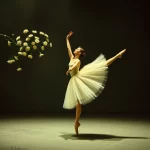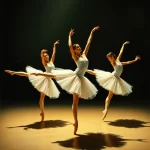Ballet: The Rite of Spring (Pina Bausch, 1975)

Introduction
Ballet, as an art form, has continually evolved, incorporating diverse influences and pushing the boundaries of traditional dance. One such groundbreaking work is Pina Bausch’s 1975 interpretation of “The Rite of Spring.” This ballet, set to Igor Stravinsky’s revolutionary score, premiered in 1975 and has since become a seminal piece in the world of contemporary dance. Bausch’s choreography, combined with Stravinsky’s powerful music, creates a visceral experience that explores themes of ritual, sacrifice, and the primal forces of nature.
Historical Background
Creation and Development
“The Rite of Spring” was originally composed by Igor Stravinsky and choreographed by Vaslav Nijinsky for its 1913 premiere in Paris. The ballet was inspired by Russian pagan rituals and folklore, depicting a sacrificial dance to ensure the arrival of spring. Pina Bausch, a German choreographer known for her innovative and expressive style, reimagined this work in 1975. Her interpretation was influenced by the social and artistic upheavals of the 1970s, including the feminist movement and the rise of contemporary dance.
Bausch’s collaboration with Stravinsky’s music was a pivotal moment in her career. She worked closely with her dancers to develop a choreography that was both raw and emotionally charged, reflecting the intensity of the score. The result was a ballet that broke away from classical conventions, emphasizing the physicality and emotional depth of the performers.
Premiere and Reception
Pina Bausch’s “The Rite of Spring” premiered on December 3, 1975, at the Wuppertal Opera House in Germany. The initial reception was mixed, with some critics praising the boldness and originality of the choreography, while others found it too avant-garde and unsettling. However, over time, the ballet gained recognition for its innovative approach and emotional impact. Notable early performances included revivals in major cities across Europe, solidifying its place in the contemporary dance repertoire.
Synopsis of the Ballet
“The Rite of Spring” is a one-act ballet that unfolds in a series of scenes, each depicting different aspects of a pagan ritual. The central theme revolves around the selection and sacrifice of a young maiden to ensure the arrival of spring.
Key Moments
- Introduction: The ballet opens with a group of dancers representing the awakening of nature. The movements are primal and grounded, setting the tone for the ritualistic events to follow.
- The Augurs of Spring: The community gathers to celebrate the arrival of spring. The choreography here is characterized by repetitive, rhythmic movements that convey a sense of collective energy.
- The Sacrificial Dance: The climax of the ballet, where the chosen maiden performs a frenzied dance, ultimately collapsing from exhaustion. This scene is both physically demanding and emotionally intense, capturing the essence of the sacrificial ritual.
Musical Composition
Composer’s Role
Igor Stravinsky, a Russian composer, created the score for “The Rite of Spring” in 1913. His music was revolutionary, characterized by complex rhythms, dissonant harmonies, and a raw, primal energy. Stravinsky’s composition played a crucial role in shaping the ballet, providing a powerful auditory backdrop for the choreography. Notable pieces within the score include “The Augurs of Spring” and “The Sacrificial Dance,” both of which are integral to the ballet’s narrative and emotional impact.
Musical Themes and Motifs
The music of “The Rite of Spring” is rich with recurring themes and motifs that enhance the narrative. Stravinsky’s use of irregular rhythms and abrupt changes in tempo mirrors the unpredictability and intensity of the ritual. The leitmotifs associated with different characters and scenes help to create a cohesive musical structure, guiding the audience through the unfolding drama.
Famous Recordings and Performances
Several iconic recordings of Stravinsky’s score have been made over the years, including performances by the London Symphony Orchestra and the Berlin Philharmonic. These recordings capture the dynamic range and emotional depth of the music, making them essential listening for fans of the ballet.
Choreography and Dance
Choreographer’s Vision
Pina Bausch’s vision for “The Rite of Spring” was to create a ballet that was both physically demanding and emotionally resonant. Her choreography emphasized the raw, primal energy of the dancers, using repetitive movements and intense physicality to convey the ritualistic nature of the story. Bausch’s innovative approach challenged traditional ballet conventions, incorporating elements of modern dance and theater to create a unique and powerful performance.
Signature Dance Numbers
- The Augurs of Spring: This dance is characterized by its rhythmic, repetitive movements, reflecting the collective energy of the community. The choreography is both physically demanding and visually striking, capturing the essence of the ritual.
- The Sacrificial Dance: The climax of the ballet, where the chosen maiden performs a frenzied, exhausting dance. This scene is a tour de force for the dancer, requiring both technical skill and emotional intensity.
Notable Interpretations
Over the years, different productions of “The Rite of Spring” have interpreted Bausch’s choreography in various ways. Some have emphasized the raw physicality of the movements, while others have focused on the emotional and psychological aspects of the story. Notable interpretations include performances by the Tanztheater Wuppertal and the Paris Opera Ballet, each bringing their unique perspective to the work.
Characters and Roles
Main Characters
- The Chosen Maiden: The central character of the ballet, selected to be sacrificed to ensure the arrival of spring. Her role is both physically demanding and emotionally intense, requiring a dancer with exceptional skill and presence.
- The Community: The group of dancers representing the pagan community. Their movements are synchronized and rhythmic, reflecting the collective energy and ritualistic nature of the story.
Supporting Characters
- The Elders: A group of older dancers who oversee the ritual and select the maiden for sacrifice. Their movements are more measured and deliberate, reflecting their authority and wisdom.
Famous Dancers
Notable dancers who have portrayed these roles include Pina Bausch herself, who performed as the Chosen Maiden in the original production, and later dancers such as Marie-Claude Pietragalla and Sylvie Guillem, who have brought their unique interpretations to the role.
Cultural and Artistic Impact
Influence on Ballet and Dance
“The Rite of Spring” has had a profound influence on the world of ballet and contemporary dance. Bausch’s innovative choreography challenged traditional conventions and opened up new possibilities for expression and storytelling in dance. The ballet has inspired countless choreographers and dancers, contributing to the evolution of the art form.
Cultural Significance
The ballet’s themes of ritual and sacrifice have resonated with audiences and artists across different media. “The Rite of Spring” has been referenced in literature, film, and theater, reflecting its enduring cultural significance. Notable adaptations include a 1987 film by director Paul Taylor and a 2013 production by the Royal Ballet, which incorporated elements of Bausch’s choreography.
Legacy and Revivals
“The Rite of Spring” continues to be performed and celebrated today, with major revivals and reinterpretations by leading dance companies around the world. The ballet’s legacy is evident in its enduring popularity and its influence on contemporary dance and choreography.
Iconic Productions
Historic Productions
One of the most famous historical productions of “The Rite of Spring” was the original 1975 premiere by Pina Bausch and the Tanztheater Wuppertal. This production set the standard for future interpretations and remains a landmark in the history of contemporary dance.
Contemporary Productions
Recent productions of “The Rite of Spring” have continued to explore and reinterpret Bausch’s choreography. Notable contemporary performances include those by the Paris Opera Ballet and the English National Ballet, each bringing their unique perspective to the work.
Production Design
The set, costume, and lighting design in various productions of “The Rite of Spring” have played a crucial role in creating the atmosphere and enhancing the storytelling. Bausch’s original production featured minimalist sets and earthy costumes, reflecting the primal and ritualistic themes of the ballet. Contemporary productions have experimented with different design elements, from elaborate sets to modern, abstract interpretations.
Critical Reception and Reviews
Initial Critical Response
The initial critical response to Pina Bausch’s “The Rite of Spring” was mixed, with some critics praising its boldness and originality, while others found it too avant-garde and unsettling. However, over time, the ballet gained recognition for its innovative approach and emotional impact.
Modern Reviews
Contemporary critics and audiences continue to praise “The Rite of Spring” for its powerful choreography and emotional depth. The ballet remains relevant and popular today, with many considering it a masterpiece of contemporary dance.
Fun Facts and Trivia
Behind-the-Scenes Stories
One interesting anecdote from the original production is that Pina Bausch herself performed as the Chosen Maiden, bringing her unique vision and intensity to the role. The rehearsals were reportedly grueling, with dancers pushing themselves to their physical and emotional limits to achieve the desired effect.
Notable Performers
Famous dancers associated with “The Rite of Spring” include Pina Bausch, Marie-Claude Pietragalla, and Sylvie Guillem, each bringing their unique interpretations to the role of the Chosen Maiden.
Trivia
- The original 1913 premiere of “The Rite of Spring” by Stravinsky and Nijinsky caused a riot in the audience due to its avant-garde music and choreography.
- Pina Bausch’s 1975 production was one of the first to reinterpret the ballet in a contemporary style, paving the way for future adaptations.
Conclusion
Summary of the Ballet’s Importance
“The Rite of Spring” is a significant work in the world of dance, known for its groundbreaking choreography and powerful music. Pina Bausch’s 1975 interpretation brought a new level of emotional intensity and physicality to the ballet, influencing generations of dancers and choreographers.
Final Thoughts
“The Rite of Spring” remains a powerful and relevant work, continuing to captivate audiences with its raw energy and emotional depth. Whether experienced live or through recordings, it is a ballet that leaves a lasting impression and continues to inspire new interpretations and adaptations.
FAQ
What is the central theme of this ballet?
The central theme of “The Rite of Spring” is the ritualistic sacrifice of a young maiden to ensure the arrival of spring, exploring themes of nature, ritual, and primal forces.
Who are the main characters in this ballet?
The main characters include the Chosen Maiden, who is selected for sacrifice, and the Community, representing the pagan society performing the ritual.
What is the most famous dance number in this ballet?
The most famous dance number is “The Sacrificial Dance,” where the Chosen Maiden performs a frenzied, exhausting dance leading to her collapse.
How long does a typical performance of this ballet last?
A typical performance of “The Rite of Spring” lasts approximately 35-40 minutes.
Are there any modern adaptations of this ballet?
Yes, there have been numerous modern adaptations of “The Rite of Spring,” including contemporary productions by the Paris Opera Ballet and the English National Ballet.
Why is this ballet considered important in the history of dance?
“The Rite of Spring” is considered important due to its groundbreaking choreography, powerful music, and its influence on the evolution of contemporary dance. Pina Bausch’s 1975 interpretation, in particular, brought a new level of emotional intensity and physicality to the ballet.





